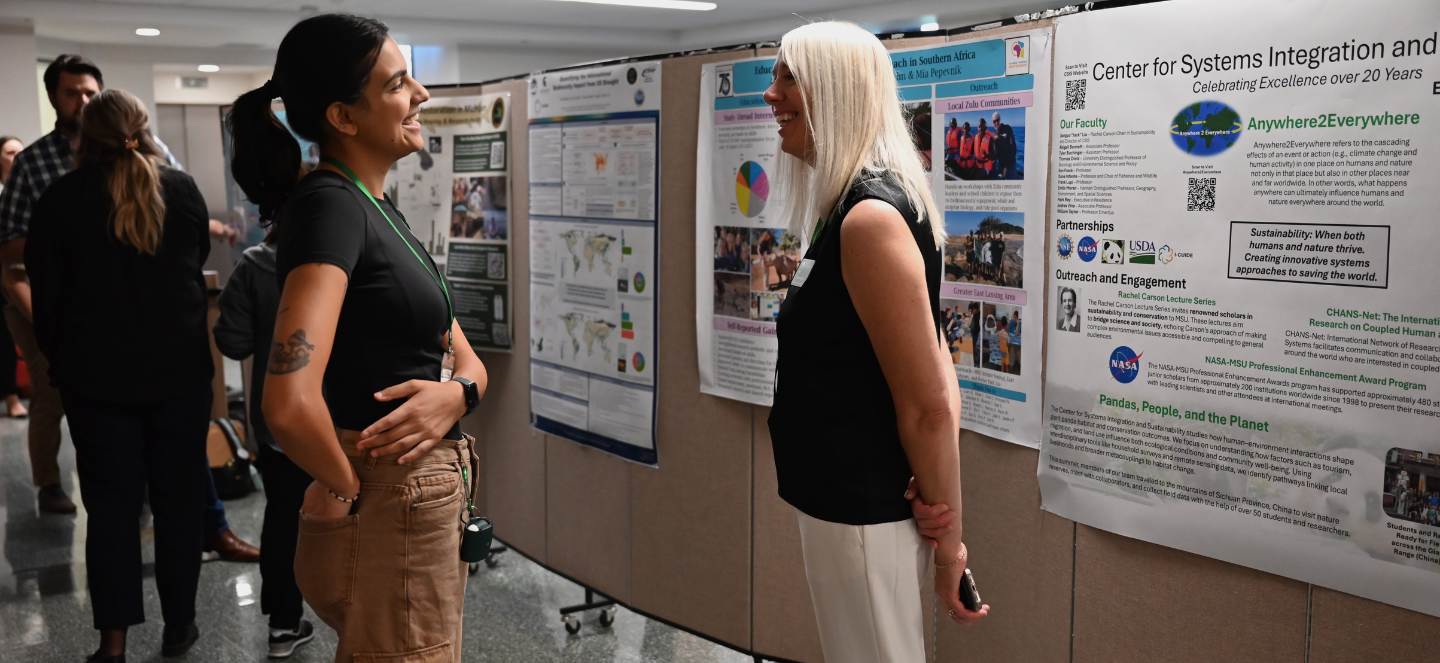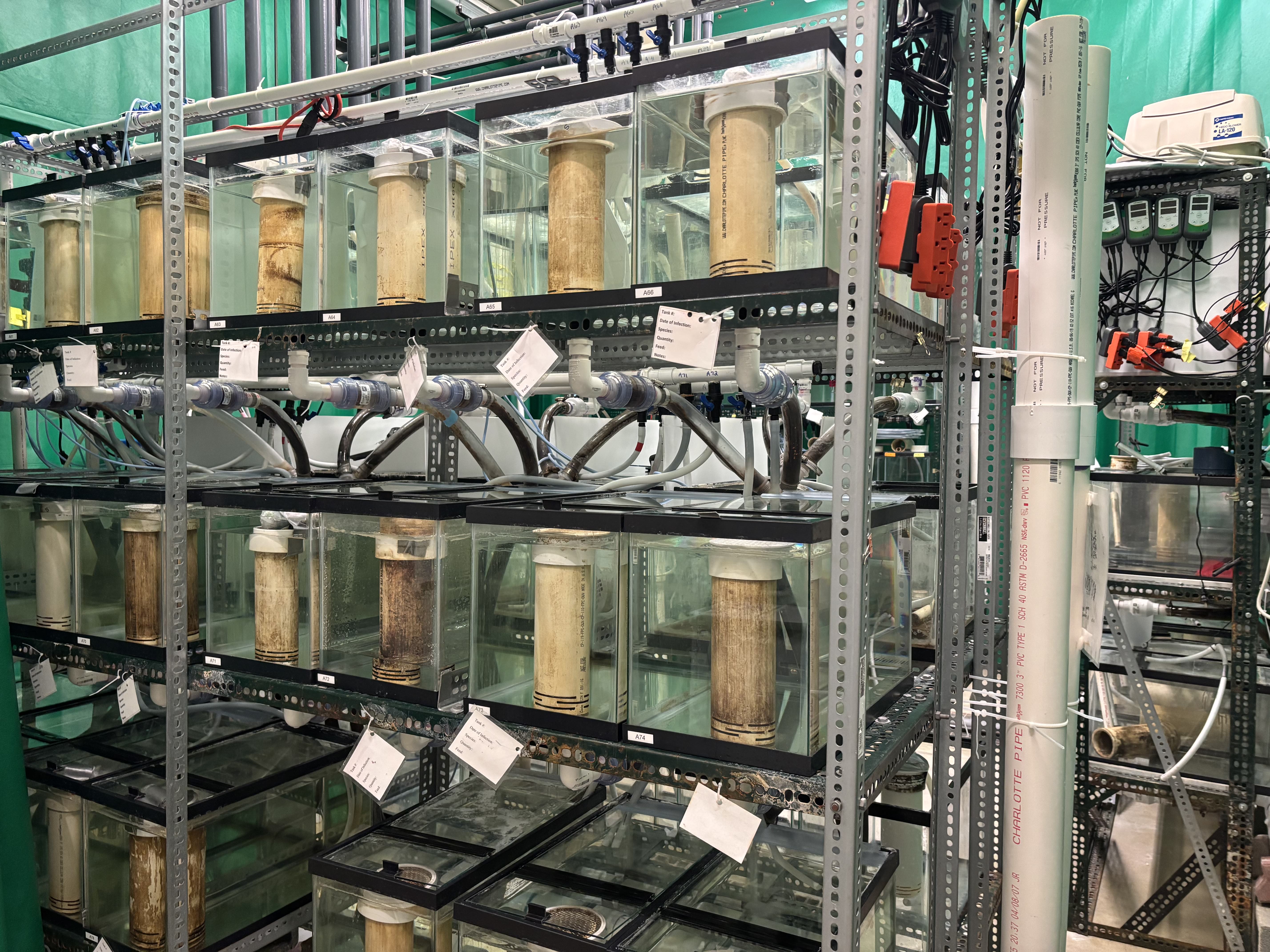
Attendees connect during the 75th Anniversary Symposium Poster & Networking Session. PHOTO by Sierra Jezuit.
Published September 25, 2025
Michigan State University’s Department of Fisheries and Wildlife (FW) marked its 75th anniversary with a two-day program Sept. 12-13, 2025, highlighting the department’s many impacts, including long-standing ties to water. Those ties date back to the 1940s and ‘50s, when sea lamprey first devastated Great Lakes fisheries and MSU scientists joined state and federal partners in the effort to restore native fish. This early work helped to establish a pattern of collaboration that still defines the department today.
Tours and demonstrations highlight water science
Day one of the anniversary began with multiple ways for faculty, alumni, and students to engage with water science. Tours included the Aquatic Animal Health Lab, where associate professor Tom Loch described his team’s partnership with the Michigan Department of Natural Resources (MDNR) to monitor fish health.

Rows of tanks inside the Aquatic Animal Health Lab support research on fish health and invasive species.
“The state puts nearly 20 million fish into Michigan waters each year, and our job is to make sure they’re not carrying pathogens when they go out,” Loch told participants.
Inside the lab, lake trout are held in flow-through tanks that replicate different water conditions, and diagnostic rooms give MSU students and veterinarians space to screen fish and water samples. Together, these facilities allow researchers to test how fish respond to pathogens and treatments. Current projects include vaccines for bacterial cold-water disease in salmonids, new egg-disinfection protocols, and monitoring a recently identified herpesvirus in lake sturgeon.
Loch explained how this work is becoming increasingly important as warming waters make pathogens like columnaris and largemouth bass virus more active.
MSU students demonstrate electrofishing techniques during a 75th Anniversary Symposium field session. PHOTO by Sierra Jezuit.
Other morning activities allowed attendees to tour the Molecular and Evolutionary Ecology Research Lab with assistant professor Sam Brunner, where demonstrations included techniques for studying genetic and ecological patterns in freshwater organisms. Participants could also join FW students conducting electrofishing surveys in the Red Cedar River, or go on a river walk with aquatic ecologists Jeremy Hartsock and Jo Latimore to explore the river’s habitats.
At the MSU Union, the Symposium Poster & Networking Session showcased more water-focused research on topics including lake sturgeon restoration, the conservation of aquatic habitats across watersheds, wastewater surveillance, antimicrobial resistance genes, and wild rice restoration at the Corey Marsh Ecological Research Center.
Policy and strategies for conservation
In the afternoon, attention shifted from lab and fieldwork to the policies and strategies needed to protect our natural resources. James Cummins, executive director of Wildlife Mississippi, delivered a keynote stressing that conservation is under pressure from both shrinking budgets and public disconnect.
“In the 1980s, about 4% of the federal budget went to natural resources,” he told attendees. “Today it’s less than 1%.”
Cummins argued that the next generation of conservationists will need to combine scientific training with policy, law, and communication so they can work effectively in Washington, in statehouses, and with communities. He added that conservation has to be explained in terms people recognize—safe drinking water, flood protection, and property values—and urged humility in building trust with hunters, anglers, and rural landowners.
James Cummins, executive director of Wildlife Mississippi, delivers a keynote address at the 75th Anniversary Symposium. PHOTO by Sierra Jezuit.
An additional keynote, from T. Douglas Beard Jr. of the U.S. Geological Survey, also called for conservation to meet people where they are. “Science needs to be organized around issues, not disciplines,” Beard said, pointing to climate change, drought, and water contamination as challenges that demand integrated approaches.
Beard emphasized that research should be communicated in plain language and include Indigenous and community knowledge, which offer valid insights into water and land.
Addressing Great Lakes challenges through collaboration
These themes set the stage for a panel discussion of the Great Lakes, where scientists and agency leaders explained how warming waters, nutrient runoff, invasive species, and shoreline development are reshaping the basin.
Lake Superior’s summer surface water temperature has risen more than four degrees Fahrenheit since 1979. Lake Erie continues to struggle with harmful algal blooms fueled by nutrient runoff. More than 180 aquatic non-native species are now established across the Great Lakes, and along Lake Michigan’s coast, the amount of shoreline covered by seawalls and other hard structures has grown from 4% in 2014 to 19% in 2021. This construction reduces natural habitat and changes how sand and sediment move.
“Eutrophication, invasive species, and climate change are going to be our big three challenges for the next decade,” said Becky Humphries, Chair, Michigan Natural Resources Commission. She pointed to algal blooms, habitat loss, and warming waters as issues already stressing Great Lakes ecosystems.
Tammy Newcomb, Senior Water Policy Advisor for MDNR, highlighted the fight to keep invasive carp out of the lakes. “This is not something any one agency can solve on its own,” she said. “Partnerships have been critical every step of the way.”
If invasive carp enter the Great Lakes in large numbers, they can overwhelm native fish by eating much of the food they depend on. Even a small breeding population could spread quickly, putting native fish like walleye and whitefish at risk.
Panelists discuss the future of university–agency partnerships in front of a packed audience at the anniversary event. PHOTO by Sierra Jezuit.
Marc Gaden, Executive Secretary of the Great Lakes Fishery Commission, also underscored the importance of partnerships to tackling problems at the scale of the Great Lakes. He pointed to the Great Lakes Acoustic Telemetry Observation System (GLATOS), coordinated at MSU by associate professor Chris Vandergoot until his passing and now continued in collaboration with assistant professor Scott Colborne, as one example of what strong university–agency partnerships look like. The network uses thousands of underwater receivers to track where fish like sturgeon and walleye travel. This information helps agencies decide where to stock fish, protect habitat, and target invasive species.
Panelists noted that partnerships like GLATOS succeed because they are built on shared objectives, long-term relationships, and science that remains relevant to management decisions.
Looking ahead
Day one of the anniversary closed with FW Fest at the Bengel Wildlife Center, where faculty, students, alumni, and community members gathered to celebrate and see live demonstrations, including lake sturgeon and sea lamprey. Their presence reflected the department’s long history of Great Lakes restoration and its ongoing work in fish health and invasive species management.
Water has remained at the center of FW throughout its 75 years. That history now faces new challenges shaped by climate change and emerging contaminants. With decades of partnerships to build on, the department enters its next era with the tools and relationships needed to address them.
Story by Aja Witt
